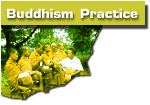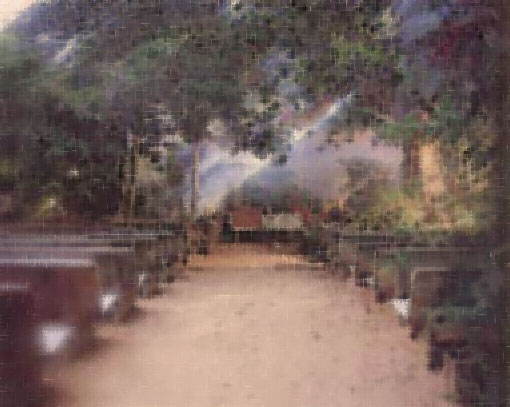 |
BANGKOK
|
||||||||
CENTRAL
|
||||||||||||
NORTHEASTERN
|
||||||||||||||
NORTHERN
|
||||||||||||
SOUTHERN
|
||||
 |
| A GUIDE TO MEDITATION CENTRES IN THAILAND |
| SOUTHERN - SUAN MOKKH |
|
MEANING
OF NAME : |
"Garden of liberation" |
FULL
NAME : |
Suan Mokkhabalarama ("Garden of the power of liberation") |
ADDRESS
: |
Amper Chaiya, Surat Thani 84110 |
TEL
: |
077 431 552, 077 431 597 |
WEBSITE
: |
http://www.suanmokkh.org/ |
DIRECTIONS
: |
Suan
Mokkh is about 640 km south of Bangkok and justwest of the Asian Highway
(Hwy. 41); Surat Thani, 53 km southeast, is the nearest city. From
Bangkok, take any southbound Rapid train and get off at Chaiya, about
40 km north of Surat Thani's Phun Phin station, then take a songtaew
to Suan Mokkh. Bangkok's Southern Bus Terminal is on the Buddha-Monthon
Road in Thonburi; both air-conditioned and non-AC buses depart here
for southern Thailand. Take a bus bound for Surat Thani or Nakhon
Si Thammarat and ask to be let off at Suan Mokkh; buses will either
let you off directly in front (KM post 71) or at the Shell station
1 km north. From the south, take trains that stop in Surat Thani (Phun Phin) or Chaiya. At Phun Phin station, ask at the bus stop in front for a bus going by Suan Mokkh. (Phun Phin, Surat Thani's train station, is 14 km west of the city.) Buses from Surat Thani bus station depart about hourly during the day. THAI flies direct to Surat Thani from Bangkok, Chiang Mai, Nakhon Si Thammarat, Phuket, and Trang; the airport is 27 km south of Suan Mokkh and 2 km west of he highway. |
MEDITATION
SYSTEM : |
Anapanasati (mindfulness with breathing)
according to the Buddha's Anapanasati Sutta. New students first
learn some theoretical background and the purpose of Dhamma practice,
then the preparations for and the 16 lessons (objects of investigation)
which make up mindfulness with breathing. Walking meditation is
also done using mindfulness with breathing; if one has difficulty
doing this, one can observe sensations in feet or legs. One practices
the first 4 lessons (the body foundation of mindfulness) to calm
one's breathing and body and to stabilize the mind. Then one refines
both thecalmness of the mind and one's understanding of how it works
by working with lessons 5-8 (the feelings foundation of mindfulness)
and 9-12 (the mind foundation of mindfulness). At any time that
the mind is sufficiently calm and stable, while practicing with
right understanding and motivation, insight can take place, even
during the first lessons. Lessons 13-16 (the Dhamma foundation of
mindfulness) further develop and perfect insight into right knowledge
(vijja ) and liberation (vimutti ). The goal
of this practice is to realize the voidness-emptiness of the 5 skhandhas (body, feelings, memory, thought, and sense awareness), that
there is nothing worth attaching to as "I" or "mine." |
TEACHING
METHOD : |
Formal instruction is given only during monthly 10-day retreats; at other times interviews, books, and tapes are available. Retreats feature Dhamma talks, interviews, group sittings, walking meditation, and morning hatha yoga. |
TEACHERS
: |
Ajahn Poh, abbot (Thai; age 60) (Foreign monks and nuns do most of the English teaching.) |
LANGUAGE
: |
English is the medium of instruction for foreigners. |
SUAN
MOKKH STYLE : |
The purpose of Dhamma practice here is to get free of the tyranny of ego in order to live peacefully (inrealization of Nibbana) and usefully (in service to Dhamma and humanity). Thus residents try to practice unselfishness in everything they do -- meditation, study, work, talk, sleep, and whatever life asks. Suan Mokkh is not a "meditation center" per se where people come only to "meditate." This is a Garden of Liberation,a place to study and practice Dhamma in a wholistic way.Study and investigation of Buddha-Dhamma given in the Pali suttas is an essential foundation for practice. Joyful service for others is the context of practiceThus cultivating RightUnderstanding and Right Aspiration with the path of samatha and vipassana becomes liberation now. Each person integrates the three as pects of study, service, and meditation in the way that works for them. With growing mindfulness and wisdom, temporary liberation blossoms into the perfect voidness empty of "I" and "mine," full of wisdom and peace. |
SIZE
: |
monks
40-70 novices sometimes a few nuns 15-25 laypeople 15-20 Thai, 15-25 foreign; (numbers increase greatly during retreats and conferences) |
DAILY
ROUTINE : |
Retreat schedules change through the ten-day period according to the teachers, but wakeup time is 4 a.m., breakfast 8 a.m., and lunch 1230 p.m. A typical schedule for meditators staying "between" retreats is 4 a.m. wakeup; 5 a.m. meditation; 6 a.m. yoga or other exercise (optional); 8 a.m. breakfast; 9 a.m. chores; 1130 a.m. meditation; 1 p.m. lunch; 430 p.m. meditation; 530 p.m. drinks; 7 p.m. tape or talk; 8 p.m. meditation; 9 p.m. individual practice; 10 p.m. lights out. |
BETWEEN
RETREATS : |
The 10-day retreats have been very popular. They provide a unique opportunity to experience the anapanasati technique in a retreat setting. (Most other meditation centres in the Theravadan tradition teach the vipassana system based on Mahasi Sayadaw's techniques.) Retreats begin on the first of every month; you must register in person a day or 2 in advance. Sometimes the 110-person capacity of the retreat cannot accommodate everyone who comes, hence the importance of coming beforehand. Upon acceptance, one must follow instructions given and be committed to staying the entire 10-day course. Late arrivals aren't possible. Retreats take place at the International Dhamma Hermitage 1.5 km east across the highway from Suan Mokkh. Foreign visitors cannot be received easily at Suan Mokkh when retreats are under way, so plan arrival after the 11th of each month. Participation in community activities is expected. One is encouraged to practice in the Suan Mokkh style. Experienced meditators who have done a retreat here before may request permission for long-term stays. |
ACCOMMODATIONS
: |
During retreats at the International Dhamma Hermitage, meditators have small individual rooms; separate buildings for men and women. Bathing is Thai-style from tanks; toilets are Asian-style. Other times visitors stay at Suan Mokkh; men have small dormitory rooms; women stay in individual rooms or dormitories; Thai-style bathing from tanks (most men's areas are in the open); mostly Asian-style toilets. Monks and novices stay in individual kutis scattered through the forest or in monk's dormitories if all kutis are occupied (they often are). Most buildings and kutis have electricity. |
WRITE
IN ADVANCE? : |
Don't. Retreat registration has to be done in person. |
OTHER
INFORMATION : |
Although
Suan Mokkh prefers not to make rules, it is much appreciated when
visitors dress and behave within the rather conservative traditions
of Thai forest wats. Laypeople observe 5 precepts. A daily charge
of 50 baht (US $2) covers food and accommodation expenses during and
between retreats. Buddhadasa Bhikkhu founded Suan Mokkh in 1932 and moved it to its present location about 10 years later. He has sought to provide a natural setting where visitors can forget "themselves" and study, practice, and realize the Dhamma. His many books, some translated into English, skilfully explain anapanasati meditation and other aspects of the Buddha's teaching. Ajahn Buddhadasa died at Suan Mokkh on July 8, 1993; He was 87 years old. The "Evolution/Liberation" newsletter comes out once a year with articles and news; it's available free by mail or at Suan Mokkh; donations support publication and distribution. The foreign library at Suan Mokkh has a variety of books on Buddhist and related topics. Most are in English, though German, French, and other languages are represented too. |
| Select here : |
|
|
